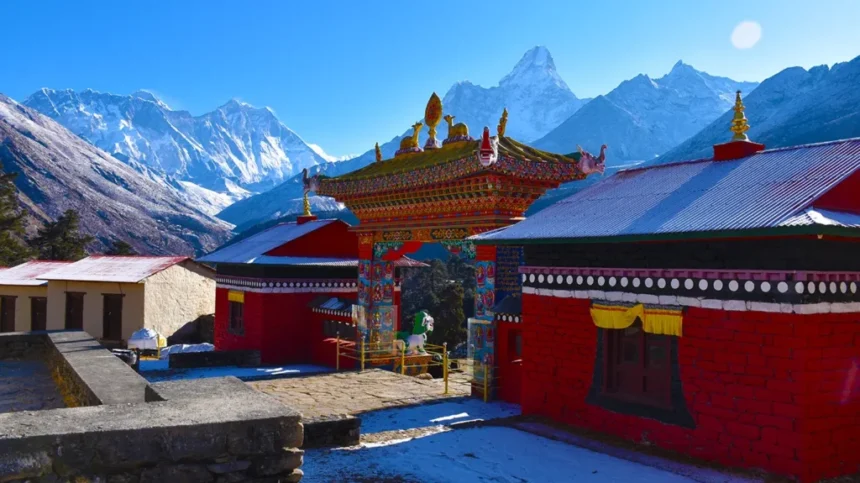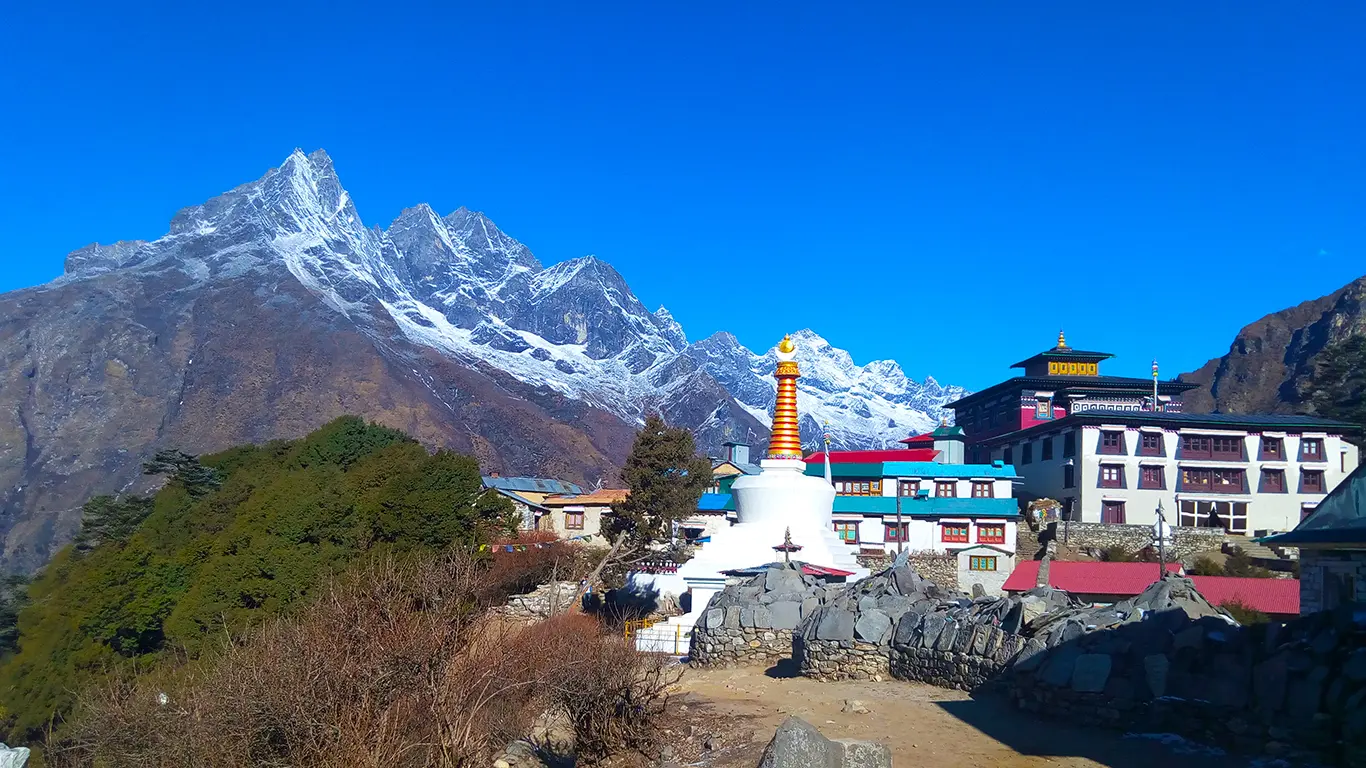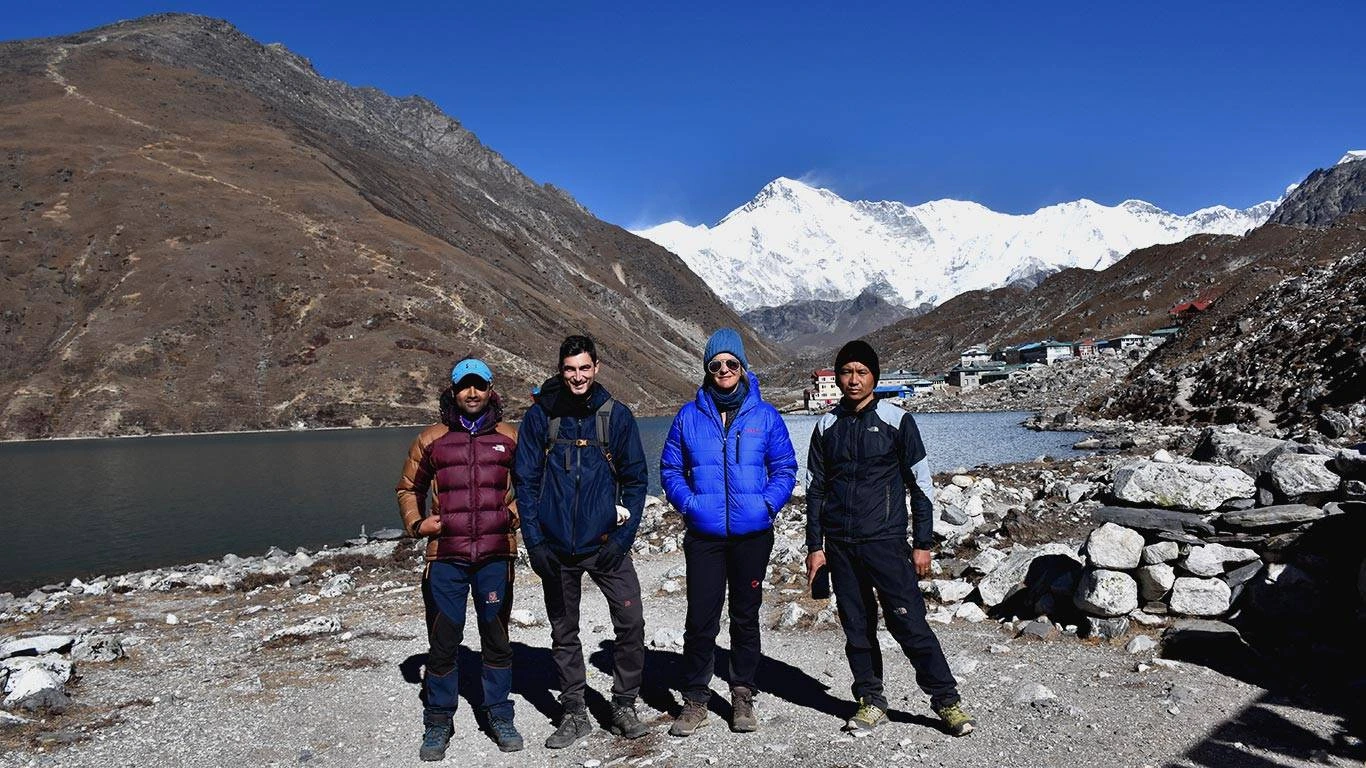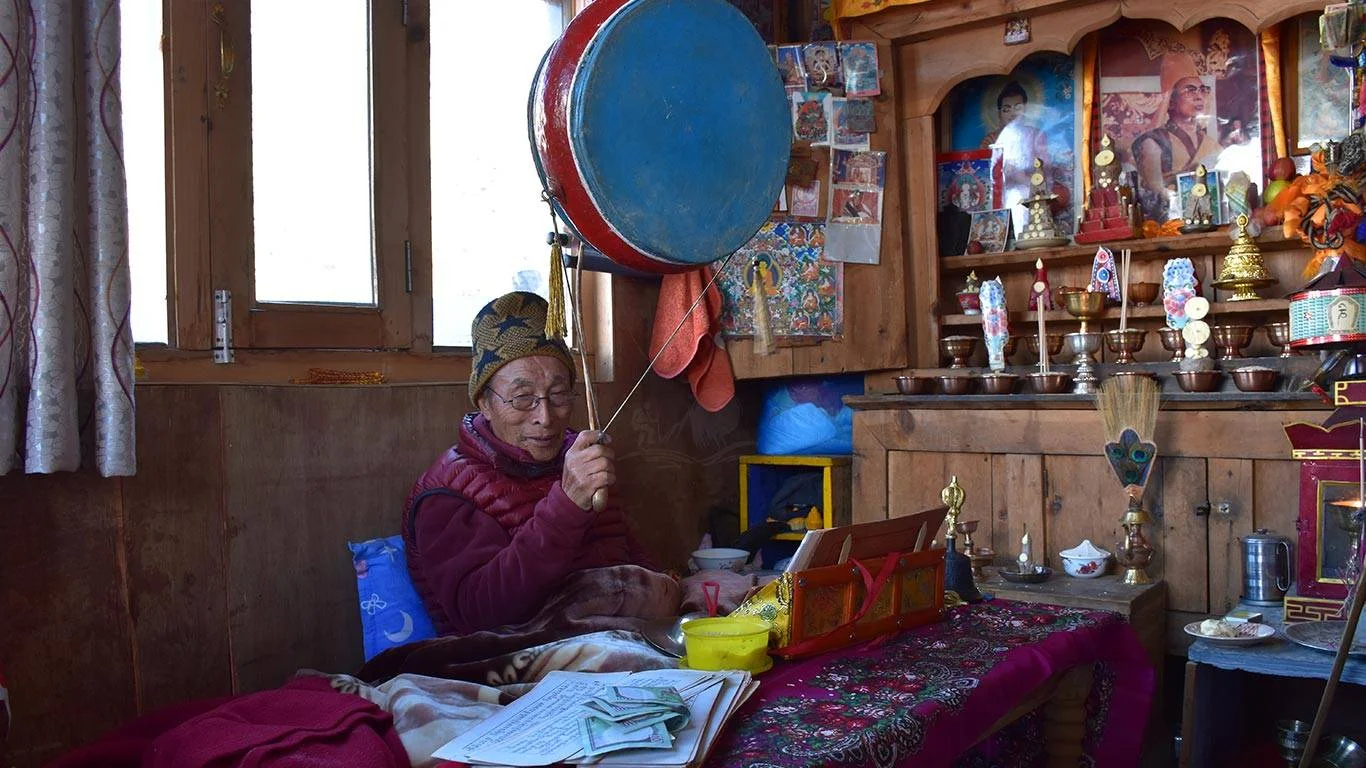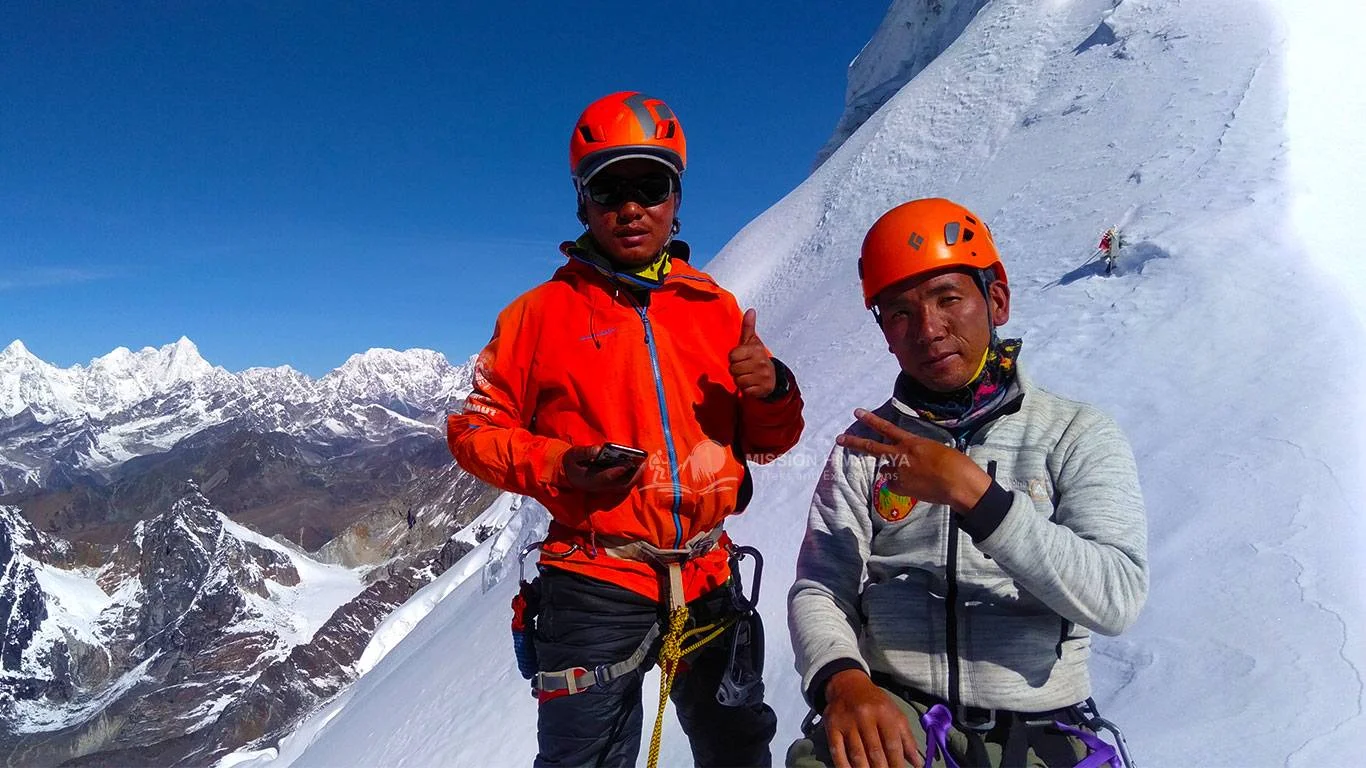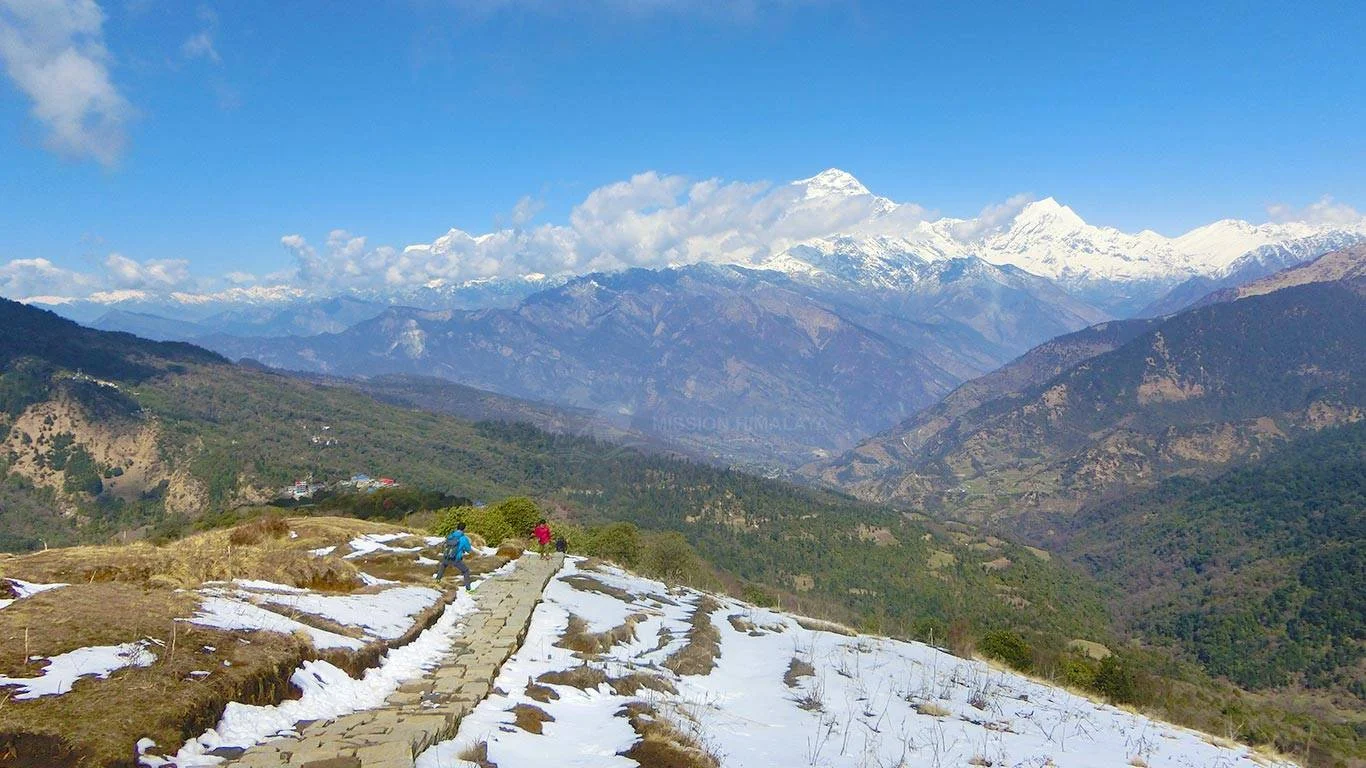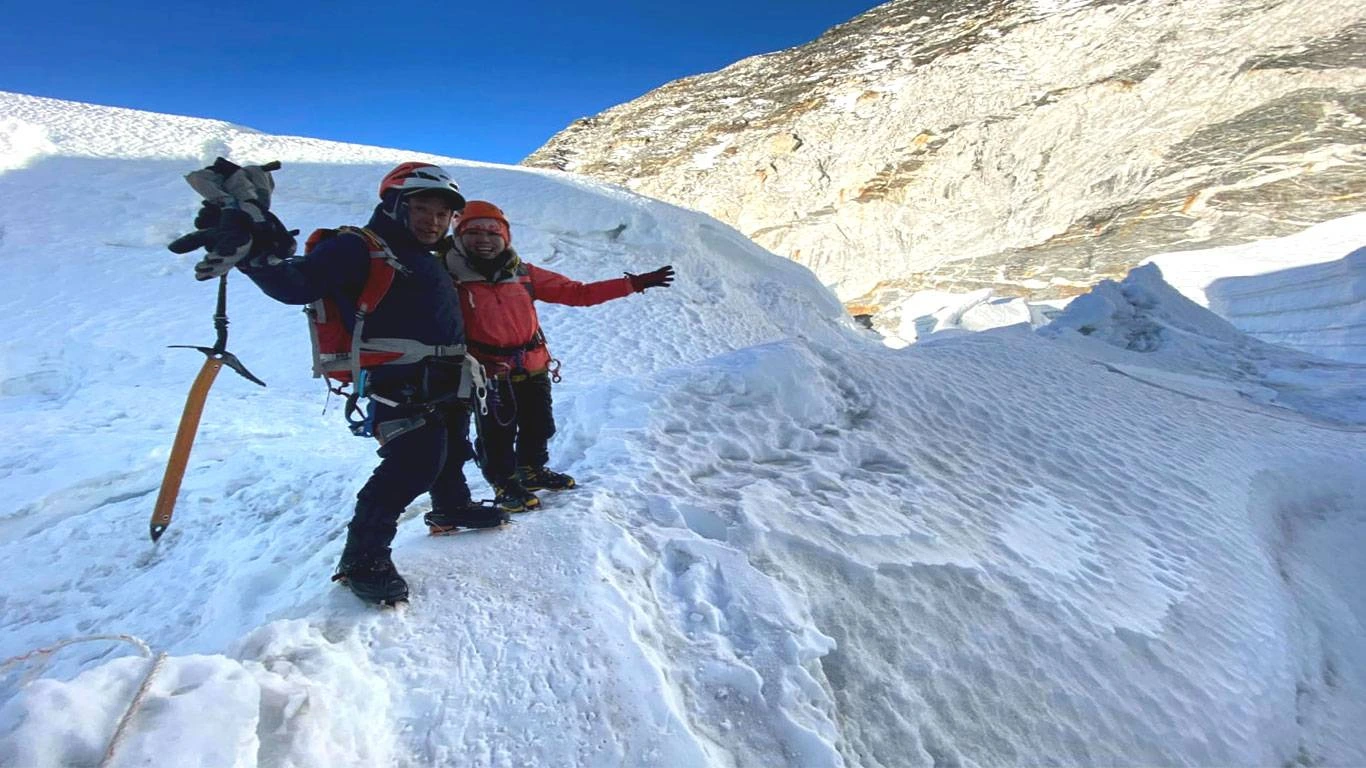The History of Tengboche Monastery: From Its Founding to Modern Day
Tengboche Monastery is one of the most important and beautiful monasteries in Nepal. It is located in the Khumbu region, high up in the Himalayas, and has been a place of peace and prayer for centuries. The history of this monastery is fascinating and tells the story of its growth and importance to the Sherpa people.
The monastery was first built in 1916 by Lama Gulu, a well-known monk in the region. It was made to serve as a place where local Sherpas could come to pray, learn about Buddhism, and find spiritual guidance. Over time, Tengboche Monastery became the center of religious life in the Khumbu region. It attracted not only local people but also visitors from other parts of Nepal and beyond.
In 1934, Tengboche Monastery faced a big challenge. A powerful earthquake hit the area and caused serious damage to the monastery. Many of its buildings were destroyed, and it looked like the monastery might never be the same again. But the Sherpa community was determined to rebuild it. With hard work and dedication, they restored the monastery to its former glory. The people of Tengboche worked together to repair the structure, and soon the monastery was once again a place of worship and peace.
Today, Tengboche Monastery stands as a symbol of strength and faith. It has been restored and now features beautiful paintings, statues, and prayer wheels. The monastery still serves as an important spiritual center for the Sherpa community and others who visit the area. The monks and nuns who live and work there continue to perform religious ceremonies and teach Buddhism to anyone who is interested.
Tengboche Monastery also plays an important role for trekkers who are making their way to Mount Everest. Many people stop by the monastery to rest, reflect, and enjoy the incredible views of the surrounding mountains. It is not just a religious place, but also a stop on the way to Everest Base Camp, where trekkers can feel the peace and spirituality of the place.
The monastery’s role in the Sherpa community is very important. It is more than just a place of prayer; it is a place where people come together to celebrate life, connect with their traditions, and find strength in their faith. The monks at Tengboche Monastery provide guidance to the people and help keep Sherpa traditions alive.
In conclusion, the history of Tengboche Monastery is rich with stories of faith, resilience, and community. From its humble beginnings in 1916 to its rebuilding after the 1934 earthquake, the monastery has stood the test of time. It continues to be a symbol of hope and spirituality, not only for the Sherpa people but also for all those who visit the beautiful Khumbu region. When you visit Tengboche Monastery, you are walking through a piece of history and experiencing the heart of the Himalayas.
The Cultural Significance of Tengboche Monastery in Sherpa Life
Tengboche Monastery is not just a beautiful building in the Himalayas; it is a very important part of the Sherpa community’s life and culture. For the Sherpas, the monastery is more than a place of prayer. It is a center for learning, a space for community gathering, and a symbol of their deep connection to Buddhism and their traditions.
The Sherpas are known for their strong spiritual beliefs, and Tengboche Monastery plays a huge role in keeping those beliefs alive. Every year, many Sherpas travel to the monastery to pray, take part in religious ceremonies, and seek blessings for their families and community. The monks at Tengboche Monastery help guide them in their spiritual practices and provide wisdom based on Buddhist teachings.
One of the most important aspects of Tengboche Monastery in Sherpa life is its role in teaching Buddhism. The monks teach the Sherpas and visitors about Buddha’s teachings, how to live a peaceful life, and how to respect all living things. The monastery is also a place where young Sherpas can come to study and learn about their religion. They grow up learning how to be kind, respectful, and wise, which are important values in their culture.
The monastery also influences local customs and traditions. For example, many important events in Sherpa life, like weddings, births, and funerals, are connected to the monastery. When a child is born, a blessing ceremony is often held at Tengboche Monastery to ensure the child grows up happy and healthy. During weddings, families visit the monastery to ask for the monk’s blessing for a long and happy marriage. When someone passes away, the monastery is the place where prayers are offered to help the soul of the departed find peace.
Tengboche Monastery is also a key part of Sherpa festivals. The most famous festival is called Mani Rimdu, which is celebrated every year. This is a special time when people from nearby villages come together to celebrate with dancing, music, and prayers. It’s a chance for the whole community to come together, celebrate their faith, and share joy. The festival is very colorful and exciting, with many people wearing traditional clothes and monks performing sacred dances.
The monastery also holds a place in the hearts of Sherpas when it comes to helping them in difficult times. When people are facing challenges, they often come to Tengboche Monastery to seek peace of mind. The peaceful surroundings and the teachings of the monks offer comfort to those in need. The monastery provides a sense of calm in the busy and sometimes hard life in the mountains.
In conclusion, Tengboche Monastery is much more than just a religious site. It is the heart of Sherpa culture and life. It teaches the values of kindness, respect, and community. It connects the Sherpa people to their traditions and faith, making it a place of great significance in their daily lives. When you visit Tengboche Monastery, you are not just seeing a beautiful building, you are experiencing the deep spiritual and cultural roots of the Sherpa people.
A Guided Tour Through Tengboche Monastery: Architecture and Key Features
Tengboche Monastery is a beautiful and peaceful place high in the Himalayas, and its architecture is just as amazing as the surrounding scenery. If you visit the monastery, you’ll be amazed by its colorful buildings, beautiful paintings, and sacred objects that make it so special. Let’s take a guided tour through Tengboche Monastery and explore some of its key features.
When you first approach the monastery, you’ll notice its large, colorful prayer flags flying in the wind. These flags are an important part of the monastery’s spirit, as they carry prayers and good wishes for everyone. As you enter the monastery, you will see its tall and impressive building with a traditional Tibetan style. The roof is shaped like a point, which is common in Tibetan Buddhist architecture, and it is covered with golden decorations. This golden touch adds a sense of peace and brightness to the entire place.
Inside Tengboche Monastery, the architecture is just as stunning. The walls are covered with bright and colorful murals that tell stories from Buddhism. These paintings are not just beautiful, but also very meaningful. They show pictures of Buddha, other holy figures, and important events in Buddhist history. The murals help visitors understand the teachings of Buddhism and the stories that are central to the religion. As you walk through the rooms, you’ll see different scenes from Buddha’s life and images of gods and goddesses. The bright colors and careful details make the paintings feel alive and full of meaning.
One of the most important rooms in Tengboche Monastery is the prayer hall. This is where the monks gather to pray and perform ceremonies. The hall is large and filled with the scent of incense, which adds to the peaceful atmosphere. In the center of the prayer hall, you will find a huge statue of Buddha, which is a symbol of peace and wisdom. The statue is surrounded by smaller statues of other important Buddhist figures. These statues are made of gold and are often decorated with flowers and offerings from the local people.
Another important feature inside the monastery is the large collection of sacred artifacts. These include prayer wheels, which are spun by the monks and visitors while saying prayers. The prayer wheels are inscribed with Buddhist mantras, and when they are turned, it is believed that the prayers are sent into the world. You will also see many beautiful thangka paintings, which are religious pictures on cloth that show important figures or teachings from Buddhism. These artifacts are not just for decoration; they have deep spiritual meaning and are used during religious ceremonies.
Tengboche Monastery is not just a place for prayer, but also a space for quiet reflection. The peaceful surroundings, combined with the beautiful architecture and sacred items, create a calming atmosphere. Whether you are visiting for the spiritual experience or just to admire the beauty, Tengboche Monastery offers something special for everyone.
In conclusion, a visit to Tengboche Monastery is a chance to see some of the most stunning Buddhist architecture and artwork in the world. From the colorful murals on the walls to the sacred artifacts inside, every part of the monastery is full of meaning and beauty. It’s a place where visitors can connect with the history, culture, and spirituality of the Himalayas.
The Scenic Beauty Surrounding Tengboche Monastery: A Trekker’s Paradise
Tengboche Monastery is not only famous for its history and culture, but also for its breathtaking views. If you ever visit this beautiful monastery in the Himalayas, you’ll be amazed by the stunning scenery around it. The monastery is located in a special spot that offers some of the most incredible views of the world’s highest mountains, including the mighty Mount Everest.
When you first arrive at Tengboche Monastery, you will be greeted by a magnificent sight. From the monastery, you can see Mount Everest in the distance. Its snow-covered peak rises high above the other mountains, and on a clear day, it looks like it’s touching the sky. Everest is often hidden behind clouds, but when the sky is clear, you can see its majestic beauty, standing tall and proud. It’s a sight that takes your breath away and makes you feel small in the presence of such greatness.
In addition to Mount Everest, there are other stunning Himalayan peaks visible from Tengboche Monastery. The surrounding mountains, like Ama Dablam, Lhotse, and Nuptse, add to the magical scenery. Ama Dablam is often called the “Matterhorn of the Himalayas” because of its unique shape. Its sharp, pointed peak makes it one of the most recognizable mountains in the region. The view of these towering peaks surrounding Tengboche Monastery makes it feel like you are in the heart of the Himalayas, surrounded by nature’s wonders.
The area around the monastery is also full of beautiful landscapes. There are lush green forests of pine and rhododendron trees, which add color and life to the surroundings. In the spring, the rhododendron trees bloom with bright red, pink, and white flowers, creating a colorful scene. The air is fresh and crisp, and the peaceful atmosphere makes it the perfect place for trekkers to stop and take a break from their journey.
As you walk around Tengboche Monastery, you’ll notice that the trails offer even more amazing views of the mountains and valleys. The path is often lined with prayer flags, which flutter in the wind, adding a sense of spirituality to the experience. The sound of the wind blowing through the trees, the chirping of birds, and the distant sound of prayers from the monastery all come together to create a peaceful and calming environment.
For trekkers, Tengboche Monastery is like a paradise. It’s the perfect place to rest and take in the views after a long day of hiking. The stunning scenery is a reward for the hard work of trekking through the mountains. Whether you are on your way to Everest Base Camp or just enjoying the beauty of the Khumbu region, Tengboche Monastery offers one of the best spots to relax and enjoy the wonders of nature.
In conclusion, the scenic beauty surrounding Tengboche Monastery is something you won’t forget. With views of Mount Everest, other towering peaks, and lush green forests, it’s a trekker’s paradise. The combination of nature’s beauty and the peaceful atmosphere of the monastery makes it a place where you can connect with the mountains and find peace in the midst of your journey.
Experiencing the Sacred Mani Rimdu Festival at Tengboche Monastery
The Mani Rimdu Festival at Tengboche Monastery is one of the most important and exciting events in the region. Every year, people from all over come to experience this special celebration, which is full of spiritual rituals and colorful cultural events. For trekkers and visitors, it’s a chance to see the rich traditions of the Sherpa community and feel the spiritual energy of the Himalayas.
The Mani Rimdu Festival takes place at Tengboche Monastery and is a celebration of the victory of good over evil. The festival is based on Buddhist traditions, and it is held to honor Buddha and the teachings of Tibetan Buddhism. The festival is very special for the Sherpa people, as it brings the community together to pray, celebrate, and ask for blessings for the year ahead.
One of the most exciting parts of the Mani Rimdu Festival is the spiritual rituals. During the festival, the monks at Tengboche Monastery perform special prayers and ceremonies to bring peace and happiness to the world. These rituals are an important part of the festival, as they help everyone connect with the teachings of Buddha and focus on the values of kindness, peace, and compassion. Visitors can watch as the monks chant prayers, burn incense, and offer blessings to those who attend the festival.
But it’s not just the spiritual side of the Mani Rimdu Festival that makes it so special – the colorful cultural events are also a major attraction. One of the highlights is the traditional mask dances performed by the monks. These dances are full of energy and are meant to drive away evil spirits and bring good luck. The monks wear colorful costumes and large, vibrant masks that represent different gods, goddesses, and spiritual beings. As they dance to the rhythm of drums and cymbals, the whole atmosphere is filled with excitement and joy. The dances are not only beautiful to watch but are also a way of telling stories from Buddhist mythology.
The Mani Rimdu Festival also includes other cultural events, such as feasting and giving offerings to the gods. During the festival, people gather in the monastery’s courtyard to enjoy traditional Sherpa food, share stories, and celebrate together. It’s a time for the community to come together, strengthen their bonds, and celebrate their shared traditions. Trekkers and visitors are often invited to join in the celebrations, which makes the festival a wonderful cultural experience for everyone.
For trekkers, the Mani Rimdu Festival is a unique opportunity to see the spiritual and cultural side of the Himalayas. Being part of this special event at Tengboche Monastery allows visitors to connect with the local community, learn about their beliefs and traditions, and experience the deep sense of spirituality that fills the air. The combination of beautiful dances, powerful rituals, and the warm, welcoming spirit of the Sherpa people makes the Mani Rimdu Festival an unforgettable experience.
In conclusion, the Mani Rimdu Festival at Tengboche Monastery is a celebration of spirituality, culture, and community. With its special prayers, colorful dances, and joyful celebrations, it is an event that attracts visitors and trekkers from all over the world. It’s a chance to experience the heart of Sherpa culture and feel the deep connection between the people, their traditions, and the mountains they call home.
Conclusion
Tengboche Monastery is not just a place to visit; it’s an unforgettable experience. From its rich history to the peaceful atmosphere and stunning views, this monastery has something special for everyone. Whether you are interested in the history of the monastery, its spiritual importance, or the beautiful surroundings, there is so much to explore.
The Tengboche Monastery has a deep connection to the Sherpa community. It has been a spiritual center for many years, offering a place for prayers, celebrations, and teachings. The monastery is also famous for its beautiful architecture, with colorful murals and sacred statues that tell the story of Buddhism. When you visit, you’ll see how the monks keep the traditions alive and how important this place is to the people who live nearby.
The scenic beauty around Tengboche Monastery is just as amazing. The view of Mount Everest and other Himalayan peaks from the monastery is breathtaking. The surrounding forests and valleys make the place feel peaceful and calm, making it a great spot for trekkers to stop and rest.
One of the best times to visit is during the Mani Rimdu Festival, a colorful celebration filled with spiritual rituals and traditional dances. The festival brings the community together, and visitors can experience the Sherpa culture in a way that’s both exciting and meaningful.
In the end, Tengboche Monastery offers a unique mix of culture, spirituality, and nature. Whether you are there to learn, to enjoy the views, or to take part in a festival, it’s a place that will leave you with lasting memories.
Birendra Duwadi by profession a trekking and tourist guide and an enterpreur whose passion is trekking in the himalayas start Mission Himalaya Treks in 2015 with a new vision to introduce Nepal Himlayas to the world. his vision is explore and documentation new trekking routes . Birendra leads Mission Himalaya, a small company that change the qualities of trekking in Nepal.

